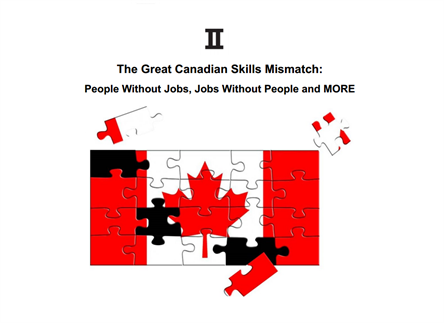The Great Canadian Skills Mismatch

I wrote a blog for Career Cruising users last year entitled 3 Solutions for Canada's Job Mismatch based on the 2010 and 2012 reports in my People Without Jobs, Jobs Without People series. Since the publication of these reports, dramatic shifts have occurred that warranted a re-analysis of the earlier findings and a third report in the series, “The Great Canadian Skills Mismatch.” The changes of most significance are:
- Labour force participation rates for those 55 and older have increased.
- New immigration programs, targeting younger immigrants with employable skills, have been established.
- Labour force demand projections have decreased.
- Canadian educational attainment levels are higher than previously projected.
- Retirement benefit provisions are moving eligibility from 65 to 67 years.
Using this and updated Statistics Canada information, the data show that shortages still exist and are far from trivial. Rather than needing an additional 2.7 million workers by 2031, the shortage is now forecasted to be just under 2 million. Similarly, projected skills shortages drop from 4.2 million to 2.3 million due to increased educational attainment levels, but a major problem will still exist.
To address these shortages we need more workers and we need them to have the right skill sets. Earlier, it was assumed that simply having an educational attainment level beyond high school would be sufficient to meet employers' skill requirements. This assumption was far too simplistic. A simple increase in educational attainment will not automatically resolve the skills mismatch problems.
Although the debate over the existence of skills mismatches rages on, many are considering only the supply-demand mismatches. We actually have multiple skills mismatches, including:
- Supply-demand mismatches
- Geographical mismatches
- Under-employment (over-skilled) mismatches
- Under-skilled/over-employment mismatches
These multiple mismatches require a variety of solutions. First and foremost, we need to increase the overall size of our labour force by increasing labour force participation rates among under-represented groups, like aboriginal Canadians, women and person with disabilities. With aggressive targets, and success, the numerical labour force shortage could be eliminated. We still need to avoid the skills mismatches by having more of the right people with the right skills in the right place at the right time. To get the right skill matches, we need to make a number of significant changes. These include:
- Drastically improving our labour market information (LMI) systems.
- Developing a national education and training strategy.
- Establishing “mandatory” career counselling opportunities for students, their parents, teachers and administrators.
- Investing in basic literacy and employability skills training.
- Implementing a variety of changes to our post-secondary system to make it more accessible, flexible, responsive, relevant and affordable.
Employers also need to become more active participants by offering more workplace learning opportunities for students like co-op and internship opportunities, providing targeted financial support for post-secondary institutions offering programs of anticipated job growth, improving hiring practices by concentrating more on competencies than credentials, expanding on-the-job training programs, and being more forthcoming about actual and anticipated job growth.
Governments, aside from also being large employers, also have critical roles to play by disproportionally investing in post-secondary institutions that are providing the educational/ training needed for the economy to expand, “forcing” institutions to re-align the balance between their research and teaching mandates, working with educational institutions to help eliminate the perceived educational hierarchy, and investing in significantly better LMI systems.
Demographic changes, along with increased skill requirements, are at the root of our labour force challenges. We need to increase the size of our labour force and ensure we avoid skills mismatches by aligning our educational attainments to the labour force needs. Success will ultimately require concerted and cooperative efforts between businesses, governments and educational institutions to address and resolve these problems. Career Cruising’s “whole-community approach” (link) is one good step in the right direction.
View Rick’s related blog post: 3 Solutions to Canada’s Job Mismatch.
